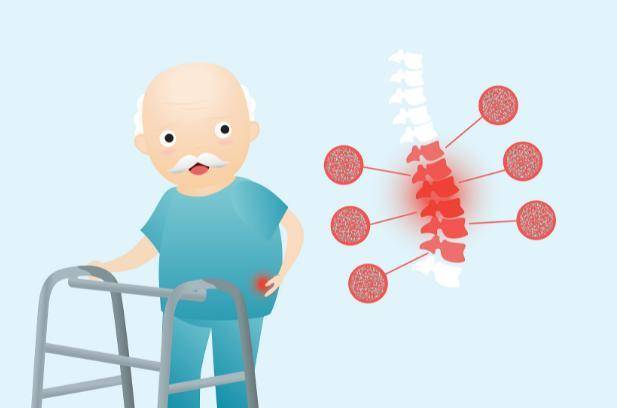Osteoporosis is one of the common diseases in the elderly and also a type of chronic skeletal disease. According to the current medical level in our country, it is difficult to cure, and can only be alleviated to some extent.
Therefore, to achieve better improvement, one must rely on oneself. It is important to pay more attention to one’s dietary habits in daily life. If not changed, the condition will only worsen.
Thus, it is essential for osteoporosis patients to adjust their diet structure from the source, control and improve their dietary habits.
What are the symptoms of osteoporosis?
1. Pain
This is the most common symptom of osteoporosis, mostly manifested as back pain, with pain spreading along the spine to both sides, worsening during movement. If you notice worsening joint pain, it is crucial to seek medical attention promptly and not delay.
2. Fractures
Patients may experience fractures with minor external force and simple movement, with longer healing time than normal and a higher risk of secondary fractures, known as fragility fractures. Common sites include the thoracic and lumbar vertebrae, followed by the hip, distal forearm, ribs, tarsal bones, and pelvis.
3. Decreased Respiratory Function
Compression fractures of the thoracic and lumbar spine can cause spinal curvature and chest deformity, leading to a significant decrease in lung capacity and maximum ventilation, often resulting in symptoms like chest tightness, shortness of breath, and respiratory difficulties.
4. Spinal Deformity
For patients with more severe osteoporosis symptoms, spinal deformities are common, often leading to height loss, kyphosis, and potential complications affecting the heart and abdominal organs, resulting in symptoms like constipation and bloating.
Is oatmeal a “trigger” for osteoporosis?
Oatmeal is a commonly consumed coarse grain due to its low calorie and high nutritional value, favored by many dieters. For those undergoing weight loss, consuming more oatmeal can improve gastrointestinal digestion and peristalsis, enhance satiety, reduce caloric intake, and aid in weight loss and slimming.
In addition to its high protein content, oatmeal is rich in minerals and trace elements, promoting bone growth and development.
Therefore, osteoporosis patients can consume oatmeal to prevent excessive protein load in the body; moderation is key.
Calcium in oatmeal can help improve osteoporosis, but it cannot cure the condition entirely. Balancing the diet, adequate intake of calcium and vitamin D, engaging in appropriate exercise, and avoiding risk factors like prolonged medication use and smoking are necessary to improve osteoporosis.
In conclusion, oatmeal can be a supplementary nutrition to improve osteoporosis but should not be considered a “trigger.”
Doctor: Three Foods to Eat Less for Bone Health
1. Sweets
Delicious sweets are a favorite of many women, as they can stimulate dopamine secretion, improving mood. While sweets can uplift mood, it is not recommended to consume them regularly in large quantities due to their high sugar content.
Frequent consumption of sweets not only raises blood sugar levels and increases fat intake, leading to obesity, but also indirectly promotes calcium loss, increasing the risk of osteoporosis.
2. High-Fat Foods
The body has a limit for ingesting saturated fatty acids. Excessive intake accelerates calcium binding in the body, forming insoluble soaps. With reduced excretion of calcium, bone growth and development are hindered, increasing the risk of osteoporosis.
3. Oxalic Acid Foods
Excessive oxalic acid intake combines with calcium in the body at all times, forming calcium oxalate. This substance is poorly absorbed and excreted in urine, rapidly accelerating calcium loss. High oxalic acid content in diet can lead to faster calcium loss and impact bone health; consuming such foods should be limited.
How else can we maintain bone health?
1. Healthy Exercise
Ensuring daily exercise is vital for bone health. In today’s society, many people lack physical activity, leading to weight gain and fat accumulation, accelerating joint degeneration and wear and affecting nutrient absorption. It is advised to include about half an hour of exercise daily to boost immunity, enhance circulation, and improve calcium absorption to foster good bone health.
2. Avoid Misuse of Medications
Avoiding medication misuse is crucial for maintaining bone health. Improper medication use may adversely affect bone health. Refrain from self-medication without professional guidance, as dosage and usage are determined by doctors based on the condition. Incorrect medication intake can impact efficacy and bone health negatively.
3. Test Bone Density
To address concerns about bone density, consider testing it. Bone density testing provides quick insights into bone health, measuring mineral density and evaluating the possibility of osteoporosis. Early diagnosis of brittle bones can prompt timely examination. Individuals with certain illnesses or using specific medications (such as steroids) may also require bone density testing.
4. Healthy Lifestyle
Adopting a healthy lifestyle including sufficient sleep, regular exercise, and abstaining from smoking and excessive alcohol consumption is essential for improving bone quality. Late nights, smoking, and heavy drinking can hinder vitamin D synthesis, leading to reduced calcium absorption and impacting bone health.
Further Reading: How Often Should Bone Density Be Checked?
It is advisable to schedule bone density checks regularly after the age of 35, as bone resorption gradually surpasses bone synthesis after this age, making it optimal to begin checks when bone density is at its peak.
Recommendation is to conduct a bone density test every 1-2 years, adjusting the frequency based on bone density assessment by the doctor. For diagnosed osteoporosis, more frequent testing may be necessary, while individuals without bone issues can reduce the frequency of checks.


